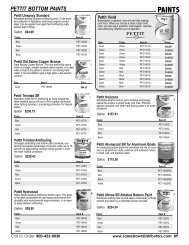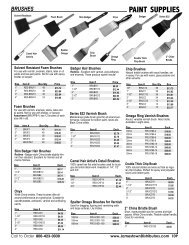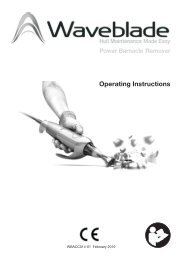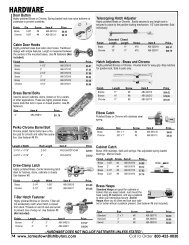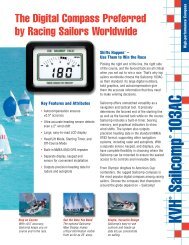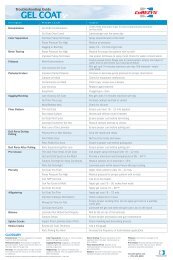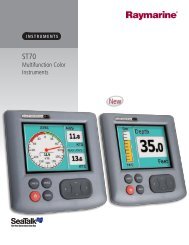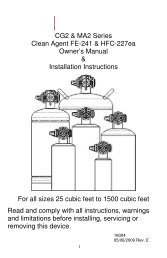technical manu al table of contents - Jamestown Distributors
technical manu al table of contents - Jamestown Distributors
technical manu al table of contents - Jamestown Distributors
Create successful ePaper yourself
Turn your PDF publications into a flip-book with our unique Google optimized e-Paper software.
gener<strong>al</strong>ly quick to dry, and easier to maintain. Our Rubbed Effect Varnish contains<br />
urethane resins which produce a harder , more scratch resistant finish.<br />
We recommend building up from bare wood with a gloss finish and topcoating with the<br />
Rubbed Effect, simply for the effect. This accomplishes two things. Gloss finishes are<br />
more weather resistant and <strong>of</strong>fer better protection against UV and weather. Building up<br />
with 3-4 coats <strong>of</strong> this before the Rubbed Effect will maximize protection. Secondly, the<br />
build-up <strong>of</strong> gloss gives the over<strong>al</strong>l appearance <strong>of</strong> the finish more depth and clarity.<br />
Epifanes does <strong>manu</strong>facture a version <strong>of</strong> Rubbed Effect c<strong>al</strong>led Woodfinish Matte. This is<br />
one <strong>of</strong> the only “Rubbed Effect” finishes containing U.V. filters. This addition makes it<br />
very sui<strong>table</strong> for exterior use. It is <strong>of</strong>ten used on the inside <strong>of</strong> Canoes and Kayaks where<br />
a non-glare finish is desired.<br />
Question:<br />
Earlier, you made a comment that you person<strong>al</strong>ly prefer to<br />
build successive coats on a boat using unthinned or full strength<br />
varnish. This seems to "fly in the face" <strong>of</strong> what we have heard for years<br />
about the necessity <strong>of</strong> 'ramping up' coats using decreasing percentages<br />
<strong>of</strong> thinned varnish. I like the sound <strong>of</strong> using unthinned builder coats<br />
but, what accounts for the difference in methods?<br />
Answer:<br />
As you know, mil thickness is everything in a Clear Finish. However, in order to ensure<br />
adhesion, it is very important to apply the first sever<strong>al</strong> coats thinned. In most cases, we<br />
recommend thinning the first coat ½ and ½ or 50%. This results in maximum adhesion<br />
giving subsequent coats something to re<strong>al</strong>ly “hang” on to. The second coat should be<br />
thinned 25% and the third, 15%. Once these se<strong>al</strong>er coats have been applied, it is time to<br />
re<strong>al</strong>ly pour on the varnish and concentrate on building some mil thickness. This can be<br />
accomplished full strength or, thinned up to 5% if you are having a tough time due to<br />
weather or conditions.<br />
Question:<br />
For those <strong>of</strong> us who are not pr<strong>of</strong>ession<strong>al</strong>s and only varnish occasion<strong>al</strong>ly, can you<br />
elaborate on the various accep<strong>table</strong> methods <strong>of</strong> cleaning and storing brushes in between<br />
uses? Also, what is the qu<strong>al</strong>itative difference between Badger hairbrushes and Chinese<br />
Bristle brushes?<br />
Answer:<br />
When it comes to cleaning and storing brushes, we are stuck on one method that works<br />
very well for us. We have tried many methods, none with any degree <strong>of</strong> success,<br />
especi<strong>al</strong>ly over the long term. Most methods <strong>of</strong> course, work great over the short period<br />
but, it’ months or years later that re<strong>al</strong>ly tells the t<strong>al</strong>e in our opinion. This is how we<br />
recommend cleaning and storing a natur<strong>al</strong> bristle brush: First, find yourself a container<br />
that is impervious to solvents (polyethylene works good). Epifanes <strong>manu</strong>factures a



